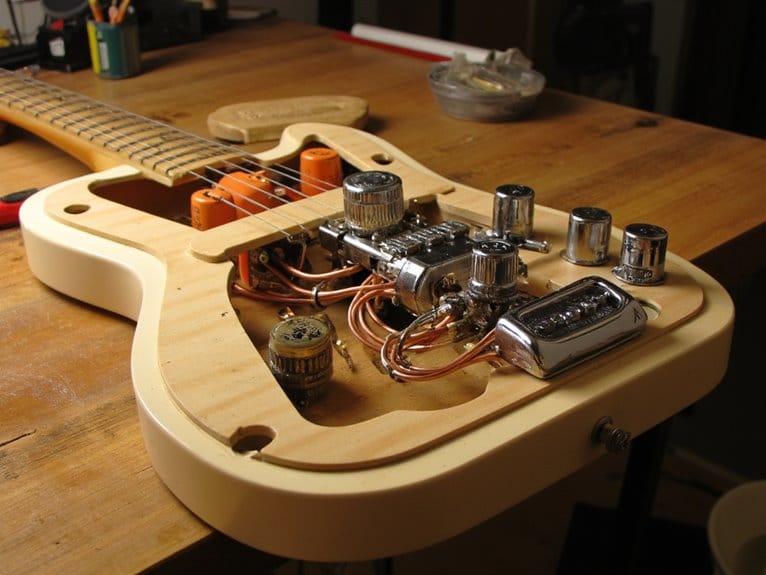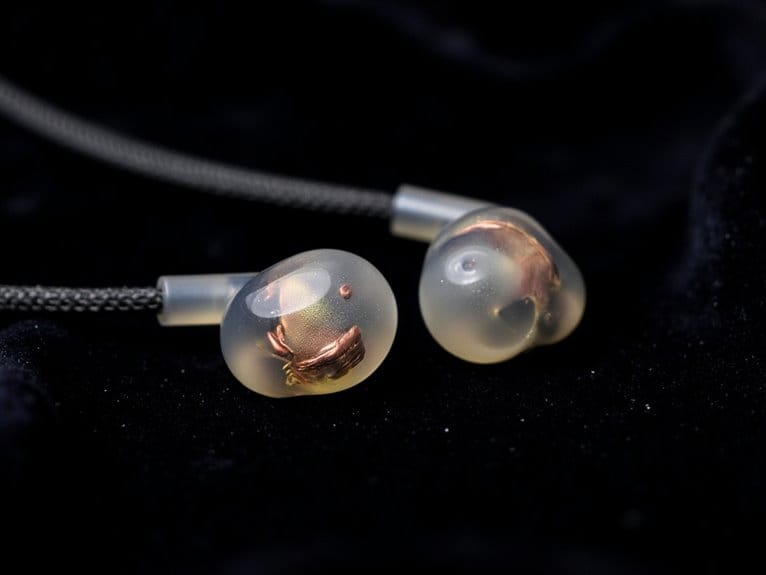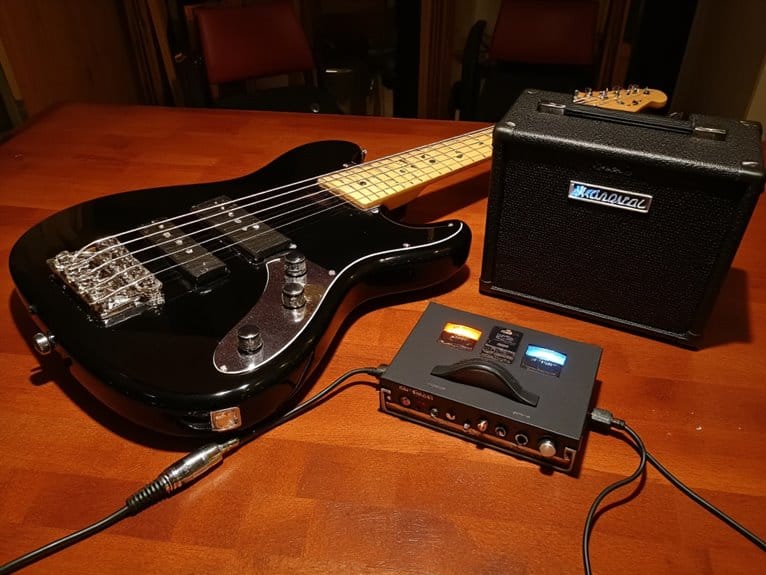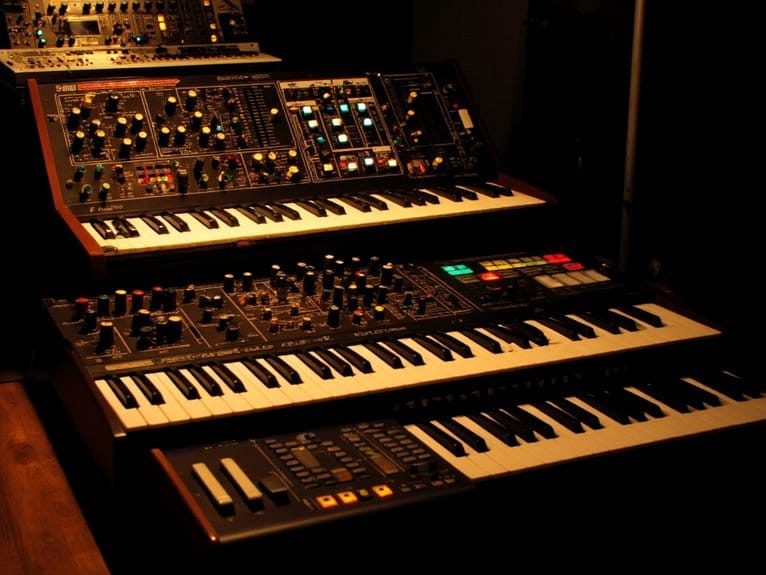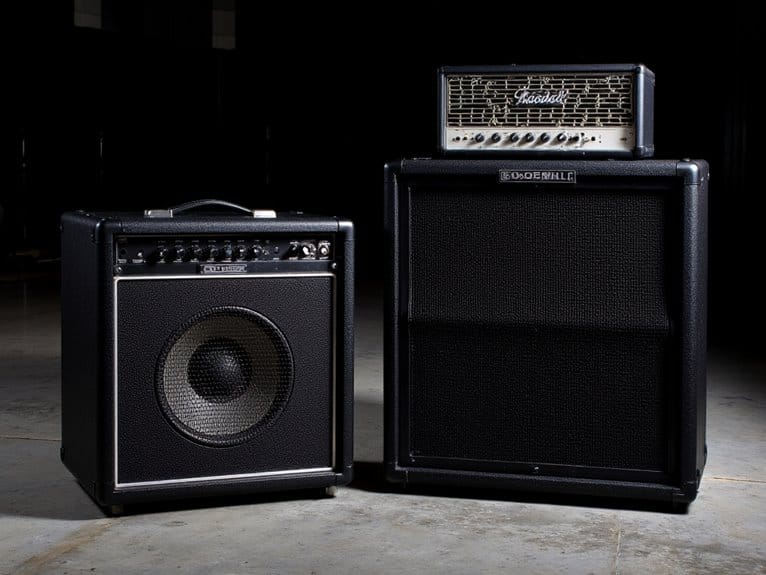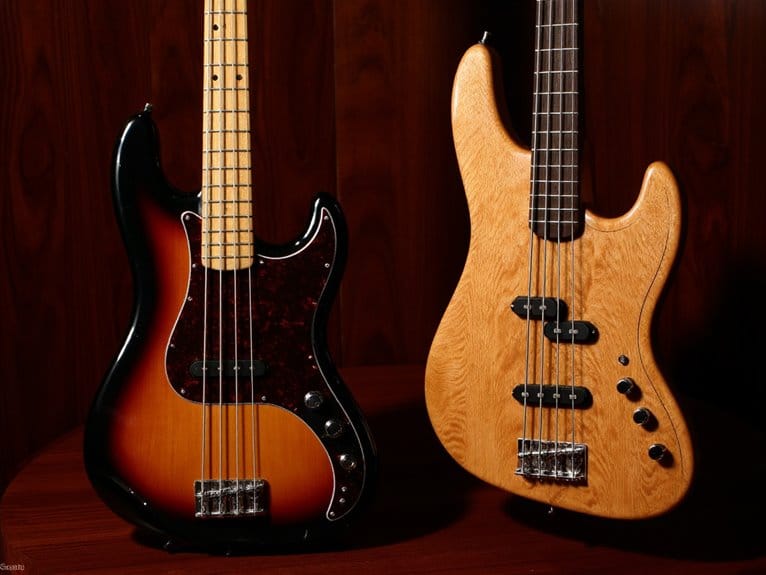Understanding Guitar Electronics: Pots, Caps, and Switches
Your guitar’s electronics operate through three key components that shape your tone: potentiometers control volume and brightness with 250kΩ values for single-coils and 500kΩ for humbuckers, capacitors filter frequencies with .022µF preserving brightness and .047µF creating warmth, and switches route pickup signals through various combinations. Audio taper pots provide smoother volume changes, while no-load designs bypass circuitry entirely at maximum settings, preserving natural pickup response and enhancing tonal clarity for more sophisticated sound control options.
We are supported by our audience. When you purchase through links on our site, we may earn an affiliate commission, at no extra cost for you. Learn more.
Notable Insights
- Potentiometers control signal volume and tone, with 250kΩ for single-coils and 500kΩ for humbuckers providing optimal frequency response.
- Capacitors shape tone through low-pass filtering, with .022µF preserving brightness and .047µF creating warmer, darker sounds.
- Toggle switches provide basic pickup selection while blade switches enable complex combinations common in Stratocasters and Telecasters.
- Proper grounding and shielding prevent electromagnetic interference and maintain signal integrity in all guitar electronic modifications.
- Audio taper potentiometers deliver smoother volume transitions compared to linear taper pots for better playing control.
How Guitar Potentiometers Control Your Sound
The humble potentiometer doesn’t look like much when you’re staring at it on your workbench, but I’ve learned that these simple components wield tremendous influence over your guitar’s voice and character.
Don’t underestimate the potentiometer—this unassuming component on your bench holds surprising power over your guitar’s sonic personality.
These variable resistors control your signal path, with volume pots regulating output loudness while tone pots, paired with capacitors, filter high frequencies to shape brightness or warmth.
Understanding potentiometer types becomes essential when you’re selecting resistance values—250k pots typically darken single-coil pickups, while 500k variants brighten humbuckers by reducing signal loss to ground.
Your taper selection matters equally, as audio taper pots provide smoother, more natural volume changes that mirror human hearing, unlike linear tapers which change resistance uniformly throughout rotation. Just as recording equipment requires careful consideration of frequency response ranges for optimal audio capture, guitar electronics demand precise component selection to achieve desired tonal characteristics.
Physical compatibility requires careful attention to bushing lengths, as short shaft pots work for pickguards while long shaft variants suit thick wooden mounts like Gibson Les Pauls. The pot’s body connects to ground to reduce unwanted noise and interference in your signal chain.
The Role of Capacitors in Tone Shaping
While potentiometers control the volume and initial tone response in your guitar’s circuit, capacitors work alongside them to create sophisticated frequency filtering that directly shapes your instrument’s tonal character through precise high-frequency attenuation.
You’ll find that different capacitor values, typically ranging from .01µF to .1µF, determine exactly where treble roll-off begins and how dramatically it affects your sound, with smaller values preserving brightness and larger ones creating warmer, darker tones.
Understanding how capacitors form low-pass filters with your tone potentiometers gives you the knowledge to customize your guitar’s voice, whether you’re seeking the crisp articulation that .022µF provides or the substantial midrange warmth that .047µF delivers. The dielectric material used in capacitor construction significantly influences the sonic characteristics, with paper-in-oil types offering musical warmth while polypropylene versions maintain neutral signal preservation.
Capacitor Values and Frequency
When you’re dialing in your guitar’s tone, capacitors act as frequency-selective filters that fundamentally shape how your instrument sounds by determining which frequencies get rolled off and at what point they start disappearing.
Higher value capacitors like .1µF begin attenuating frequencies lower in the spectrum, creating warmer, darker tones that emphasize bass and midrange content.
Conversely, smaller values around .022µF target primarily high frequencies, maintaining brightness while offering subtler tonal shifts.
Your capacitor selection criteria should balance desired darkness against maintaining articulation, with most players finding sweet spots between .022µF and .047µF for general use.
These frequency modulation effects become particularly pronounced when tone pots reach minimum settings, where capacitors create parallel paths that shunt treble frequencies directly to ground.
The impact of capacitor values becomes especially important when paired with different pickup configurations, as humbuckers and single-coils respond differently to frequency filtering based on their inherent tonal characteristics.
Just like how audio interfaces provide different input options for various recording needs, guitarists can experiment with different capacitor values to find the perfect tonal balance for their playing style and musical genre.
Low-Pass Filter Formation
As electrical current flows through your guitar’s circuitry, capacitors naturally form what engineers call low-pass filters, creating the fundamental mechanism that shapes your instrument’s tonal character by selectively removing high frequencies while preserving the warmth of lower ones.
This frequency dependence occurs because capacitors exhibit lower reactance at higher frequencies, effectively creating a short circuit to ground that removes treble content through signal shunting.
The capacitor interaction with your tone pot creates these essential low pass characteristics:
- Variable resistance control – Your tone pot adjusts how much high-frequency signal reaches the capacitor.
- Progressive attenuation – High frequencies roll off at approximately 6 dB per octave rather than cutting sharply.
- Resonance effects – Real circuits produce complex behaviors near the cutoff frequency, unlike theoretical models.
Just as 24-bit/192 kHz recording interfaces capture the full spectrum of audio detail in professional studios, guitar electronics must preserve signal integrity throughout the frequency response curve.
Modern guitarists can further enhance their tonal shaping capabilities by incorporating multi-effects pedals that offer digital tone control and cabinet simulations alongside traditional analog circuitry. Professional musicians often rely on true bypass functionality in their signal chain to maintain pristine tone quality when effects are disengaged.
Tonal Character Customization
Since capacitors determine which frequencies get filtered to ground, I’ve found that selecting the right capacitance value becomes your most powerful tool for customizing your guitar’s tonal character, whether you’re working with the instrument’s built-in electronics or modifying pedal circuits.
These custom tone techniques start with understanding how larger values like 0.047µF create darker, warmer sounds by rolling off more midrange content, while smaller 0.022µF caps preserve brightness by targeting only the highest frequencies.
Your capacitor selection strategies should match your pickup type—brighter single coils benefit from larger caps to tame harshness, while humbuckers pair well with smaller values to maintain clarity. When working with single coil pickups, the higher capacitance values help reduce any unwanted brightness that might compete with their naturally crystal clear tone.
I always recommend listening tests to evaluate how smoothly your tone control shifts and whether the frequency cutoff matches your playing style. Just as signal-to-noise ratio affects audio quality in recording equipment, proper capacitor selection minimizes unwanted frequencies while preserving the essential characteristics of your guitar’s voice.
Just as upgrading guitar nuts from plastic to quality materials can dramatically improve sustain and tonal clarity, replacing stock capacitors with higher-grade components often reveals similar sonic improvements in your instrument’s overall voice.
Comparing .022 µF Vs .047 µF Capacitor Values
When you’re deciding between .022 µF and .047 µF capacitors for your guitar’s tone circuit, you’re fundamentally choosing how dramatically your tone control will affect the frequency response, with each value creating distinctly different tonal characteristics that’ll shape your overall sound.
The .022 µF cap maintains more brightness and clarity by primarily targeting treble frequencies, while the .047 µF version cuts deeper into the midrange spectrum, producing noticeably warmer, darker tones that can transform your guitar’s voice.
I’ve found that understanding these frequency response differences is significant because they directly impact how usable your tone knob becomes, affecting everything from subtle tonal adjustments to dramatic sonic transformations.
Frequency Response Differences
While both .022 µF and .047 µF capacitors serve the same basic function in your guitar’s tone circuit, their frequency response differences create distinctly audible tonal characteristics that I’ve found can make or break your sound.
Your capacitor selection directly determines where the cutoff frequency sits, fundamentally altering the frequency range affected when you roll back that tone knob.
The mathematical relationship is straightforward: doubling capacitance roughly halves your cutoff frequency, which creates these distinct behaviors:
- 0.022 µF caps primarily target high frequencies, preserving brightness and upper-mid clarity.
- 0.047 µF caps extend roll-off deeper into midrange territory, producing warmer, darker tones.
- Cutoff positioning shifts the entire filter response curve, changing how aggressively frequencies attenuate.
This difference becomes most apparent with single-coil pickups, where brightness variations are more pronounced.
Tonal Character Impact
Nothing quite reveals the true character differences between .022 µF and .047 µF capacitors like hearing them side-by-side in the same guitar, and I’ve spent countless hours swapping these values to understand exactly how each one shapes your instrument’s voice.
Your tonal preferences will ultimately determine which capacitor serves you best, though don’t fall for capacitor myths about exotic materials making dramatic differences—it’s the capacitance value that matters most.
| Aspect | .022 µF | .047 µF |
|---|---|---|
| Tone Control Response | Subtle, gradual darkening | Pronounced, aggressive darkening |
| Best Pickup Pairing | Darker humbuckers | Bright single-coils |
| Musical Applications | Rock, blues clarity | Vintage warmth, jazz |
| Frequency Preservation | Retains upper mids/highs | Fuller, warmer midrange |
The .047 µF creates that vintage warmth you hear on classic recordings, while .022 µF maintains clarity for modern applications. When testing capacitor values in different environments, consider that noise cancellation technology in your recording setup can help isolate the subtle tonal differences between capacitor values during A/B comparisons.
No-Load Potentiometers and Their Advantages
Among the most misunderstood yet transformative guitar electronics modifications I’ve encountered, no-load potentiometers represent a relatively simple upgrade that can dramatically improve your instrument’s tonal clarity and output.
While standard pots function from positions one through ten, no-load variants feature a significant difference: at maximum setting, they effectively remove themselves from your circuit, creating a true signal bypass that eliminates the typical resistance load.
The no load benefits become immediately apparent when you experience this direct signal path, which preserves your pickups’ natural high-frequency response and prevents the dulling effect common with standard potentiometers.
The transformative clarity you’ll experience through this uncompromised signal path immediately demonstrates why no-load modifications have become essential upgrades.
Here’s what you’ll notice:
- Increased output and brightness
- Fuller bass and treble extension
- Pure, unaltered pickup tone without passive attenuation
This enhancement proves particularly valuable for budget guitars where factory electronics may not fully showcase the instrument’s potential, allowing players to achieve better tonal performance without investing in premium instruments.
Guitar Switch Types and Signal Routing
The heart of your guitar’s switching system determines how your pickups connect to your output jack, and understanding these mechanisms will reveal countless tonal possibilities I’ve discovered through decades of rewiring instruments.
Toggle switches offer simple on/off functions, while blade switches—common in Strats and Teles—use wipers that slide across terminals to create sophisticated pickup combinations.
Rotary switches handle complex multi-pickup configurations, and push-button switches enable momentary coil-splitting effects.
The real magic happens with switch functions in 5-way selectors, where positions 2 and 4 automatically parallel two pickups, creating those distinctive in-between tones that define classic guitar sounds.
Super switches expand possibilities further with 24 terminals, allowing series wiring, phase switching, and custom routing configurations impossible with standard hardware.
Potentiometer Construction and Resistance Values
While switches route your signal, potentiometers control its strength and character through a surprisingly simple mechanism that I’ve found affects your tone more than most players realize.
These potentiometer types come in two main physical configurations: rotary pots with circular resistive tracks that your shaft rotation controls, and slide potentiometers with linear tracks commonly found in mixing boards.
The resistance values you choose dramatically impact your guitar’s voice through these three key applications:
- 250kΩ pots – Perfect for single-coils, reducing brightness by bleeding high frequencies
- 500kΩ pots – Standard for humbuckers, preserving clarity and treble response
- 1MΩ pots – Increases brightness further, especially beneficial with low-output pickups
Your pot’s resistance value functions as a voltage divider, fundamentally determining how much signal reaches your amplifier versus bleeding to ground.
When upgrading electronics, many players discover that flimsy potentiometers can compromise an otherwise excellent pickup installation, making quality component selection crucial for lasting performance.
Wiring Configurations for Custom Electronics
Beyond selecting the right resistance values, your wiring configuration becomes the architectural blueprint that determines how these components interact. I’ve discovered that even subtle changes can completely transform your guitar’s sonic personality.
Custom pickup configurations open endless possibilities, whether you’re implementing coil-splitting humbuckers for versatile single-coil tones or experimenting with series/parallel switching to alter output levels and midrange presence.
Multi switch setups, utilizing everything from push-pull pots to mini toggles and rotary switches, let you access complex routing options without cluttering your guitar’s aesthetics. These configurations become especially valuable when integrating high-gain pedals that benefit from true bypass circuitry to maintain signal integrity.
I’ve found that proper grounding remains critical throughout these modifications, as even elaborate custom wiring becomes useless if electromagnetic interference creeps in through poor shielding or weak ground connections. Professional bassists often incorporate DI capabilities directly into their signal chain to maintain sound quality when connecting to live sound systems and recording equipment.
When powering multiple pedals in your signal chain, consider that isolated power supplies provide cleaner performance compared to daisy chain configurations, which can introduce unwanted noise into your carefully crafted guitar electronics.
Frequently Asked Questions
Can I Install Guitar Electronics Myself or Do I Need Professional Help?
You can handle DIY installation if you’ve got basic soldering skills and proper tools. However, you’ll need professional services for complex modifications or if you lack experience to avoid damaging your guitar.
How Often Should I Replace Potentiometers and Capacitors in My Guitar?
You don’t need scheduled replacement intervals for potentiometer lifespan or capacitor replacement. Replace pots when they’re crackling or scratchy, typically after 10-20 years. Replace capacitors only if you’re experiencing tone loss or muddiness.
Will Changing My Guitar’s Electronics Void the Manufacturer’s Warranty?
Yes, changing your guitar’s electronics will likely void the manufacturer’s warranty. Most brands consider electronics modifications unauthorized alterations that affect warranty coverage. You should consult your specific warranty terms before making changes.
What Tools Are Required for Basic Guitar Electronics Maintenance and Repairs?
You’ll need a 30-watt soldering iron, rosin-core solder, precision screwdrivers, wire cutters, and a multimeter for basic guitar electronics work. Master proper soldering techniques and reference wiring diagrams to guarantee successful repairs.
On a final note
You’ve now got the essential knowledge to modify your guitar’s electronics with confidence, whether you’re swapping capacitors for different frequency responses, upgrading to no-load pots for maximum pickup output, or rewiring your switching configuration. These components work together as a complete system, and understanding their individual roles helps you make informed decisions about your instrument’s voice and performance characteristics.

